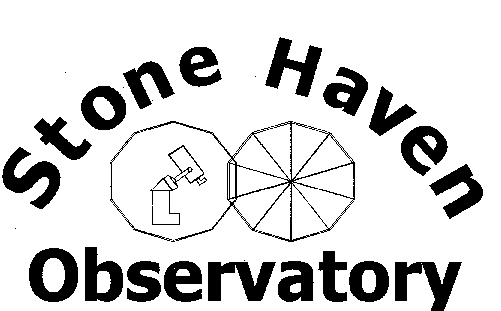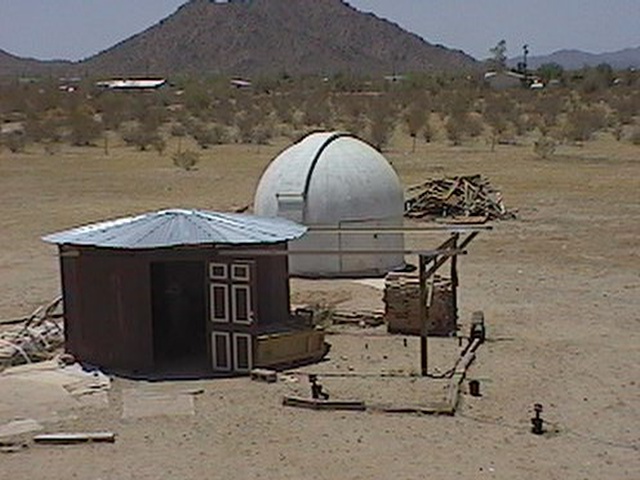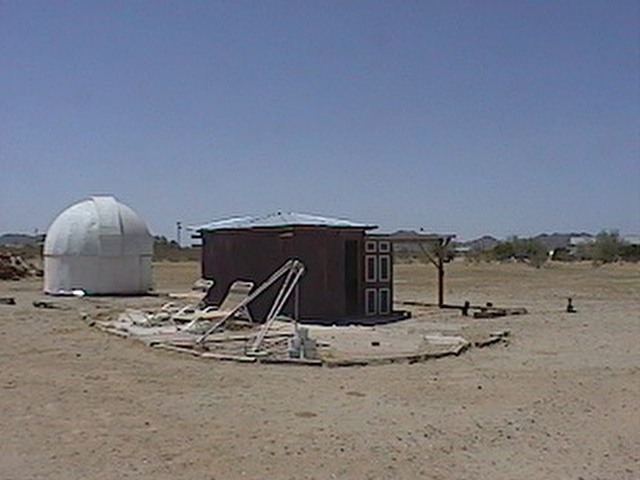

If you could indulge my ravings for just a moment, I'd like to share a little story about the creation/evolution of Stone Haven Observatory.
At the time I moved to the "boonies", I had just been soundly trounced by a divorce and several other unfortunate attempts at relationships. I had fully intended to just become a hermit, and this location promised to fulfill that end. One night, in a drunken stupor, as I sat on the roof of my house, I noticed how many stars I could see, along with the river of the Milky Way passing overhead. This was a sight I had not seen since I was a boy, spending the summers in Canada. I had always had an interest in astronomy, just no idea on how to actually do it.
So, I looked up the local astronomy shop called, strangely, "The Astronomy Shoppe", wandered in one day with my credit card and asked them what I should buy. They were very nice and I walked out with a brand new Celestron Celestar 8" SCT. I was not in the least prepared for what I would see through it. I followed the instructions for setup/finder collimation, aimed it at a telephone pole 1/2 mile away, and saw wood grain and a knot hole the size of my fist! My first thought was something like, "Whoa! This is a SERIOUS instrument! Cool!" I spent the better part of the next 2 years trying and mostly failing to figure out how to set up the thing, aim it and find what I was after. Frustration set in.
Until a friend of mine suggested we reserve a spot for public viewing at Kitt Peak. It seems they had just begun a program where for $35 you could spend a few hours with an experienced telescope operator and a 16" Meade LX200. That operators name was Adam Block. (He's since left KPNO.) He was wonderful! Very knowledgable, very helpful, very friendly. We saw a whole bunch of things that night, but the biggest thing for me was an understanding of what to EXPECT to see at the eyepiece. That, more than anything, inspired me to settle down and try harder. The next night, I found M51 and M27. Spectacular!
Once I started getting better at location and identification, I began to notice my neighbors street light more. (It's too bad I installed it for her myself, too, before I got the scope, otherwise, I'd have chosen a different fixture.) I decided to put up a couple walls to block the surrounding lights, such as they are. I enlisted my daughter to help construct a simple enclosure. The rest is history. And described below.
Thanks for your patience, and I hope you can find some inspiration as I did. Now, on to Stone Haven Observatory.


This is the view of Stone Haven Observatory looking west from the roof of my home.
You may notice it has 10 sides, each of which are
made from 4' x 8' panels of 3/8" thickness, cut down to 6' in height. These panels are
framed on 10-4" x 4" posts, shaped to accomodate the angle of the plywood panels, sunk
3' into the ground and secured by post hole cement mix. There are 2" x 4" top and bottom
plates rabbitted and dado'd into the posts at the top and bottom. This configuration was
easy to construct in a weekend and yields an approximate circle 12' 6" in diameter. The 6
panel mahogany door with deadbolt lock was recently added as a security measure. It also
gives a rewarding "thunk" when closed. The edges of the inside panels will be painted a
contrasting color to aid in night time location. :-0
Along the walls are hung a couple of shelves and cabinets for eyepieces, charts, binoculars
and such, along with hooks for clip boards and various lists. Recently added is a hutch for
the computer and reference and log books, plus a book shelf, I guess for books I don't care
too much about. :-)
I installed a row of benches along the South wall for star parties. Room for maybe 10 adults
or 15 kids to take a load off or check the sky with binoculars. The place is wired for AC, with
a dimmer switch for specially wired outlets that hold night lights fitted with red bulbs.
There are also several conventional outlets for PC, fan, other scopes etc.
The rolloff roof
was completed on January 14,1999. The rolloff roof is
constructed of 2" x 6"es in a rectangular "dolly" with a ten sided pitched "spider" on top.
The "ribs" obviously match up to the posts holding up the walls.
The dolly rolls along 2-20' long pieces of 3"x3" angle iron steel rails, (recently extended to
22' in length, allowing unrestricted viewing to the north. Whee!) When closed, the
corners of the
dolly rest atop 4 of the posts holding up the walls. When closed, it is secured by 4
turnbuckles and a pad lock. When open, it is secured to one of the vertical 4"x4" posts at
the end of the rails, and a chain to one corner of the observatory. This secures the roof if
there are substantial winds during observing.
The whole thing is covered with corrugated
tin roofing materials. Around the edges of the roof are attached 4' long pieces of 6" wide
rubber
baseboard, to reduce weather invasion, (not by enough, however. Suggestions are welcome.)
The scope is covered when not in use by a Desert Storm mylar cover.
Notice also, off to the left of the observatory the chaise-lounges used for meteor shower
observing. In front of them is the (usually) polar aligned "Pieramyd" mount I use for remote
star parties and such. This was a design "borrowed" from Prof. Russell Nidey in Cottonwood.
Very nice, very stable platform, consequently given the "OK" from the Professor himself. :-)
Click on "More on H.M.O." for more closeup, interior views.
Pier Construction Details
Some photos of the Pier and Wedge
